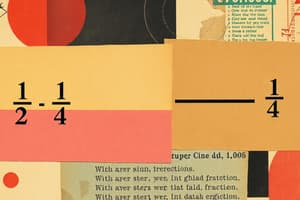Podcast
Questions and Answers
A fraction represents a part of a whole and consists of a numerator and a ______.
A fraction represents a part of a whole and consists of a numerator and a ______.
denominator
When adding like fractions, we keep the ______ the same.
When adding like fractions, we keep the ______ the same.
denominator
To add unlike fractions, one must first find a common ______.
To add unlike fractions, one must first find a common ______.
denominator
When subtracting like fractions, we subtract the ______ and keep the denominator the same.
When subtracting like fractions, we subtract the ______ and keep the denominator the same.
When multiplying fractions, we multiply the ______ together.
When multiplying fractions, we multiply the ______ together.
To divide fractions, we multiply by the ______ of the divisor.
To divide fractions, we multiply by the ______ of the divisor.
For multiplying fractions, after calculating the new numerator and denominator, we may need to ______ the fraction.
For multiplying fractions, after calculating the new numerator and denominator, we may need to ______ the fraction.
In the example of adding unlike fractions, the result of ______ and ______ gives us the final fraction.
In the example of adding unlike fractions, the result of ______ and ______ gives us the final fraction.
When subtracting the fractions
(2/3 and 1/4), the result is ______.
When subtracting the fractions (2/3 and 1/4), the result is ______.
Flashcards are hidden until you start studying
Study Notes
Fractions
- Definition: A fraction represents a part of a whole and consists of a numerator (top number) and a denominator (bottom number).
Adding Fractions
-
Like Fractions:
- Add the numerators.
- Keep the denominator the same.
- Example: ( \frac{2}{5} + \frac{3}{5} = \frac{2 + 3}{5} = \frac{5}{5} = 1 )
-
Unlike Fractions:
- Find a common denominator (LCD).
- Convert each fraction.
- Add the numerators.
- Example: ( \frac{1}{4} + \frac{1}{6} )
- LCD = 12; ( \frac{1}{4} = \frac{3}{12}, \ \frac{1}{6} = \frac{2}{12} )
- Result: ( \frac{3}{12} + \frac{2}{12} = \frac{5}{12} )
Subtracting Fractions
-
Like Fractions:
- Subtract the numerators.
- Keep the denominator the same.
- Example: ( \frac{5}{8} - \frac{3}{8} = \frac{5 - 3}{8} = \frac{2}{8} = \frac{1}{4} )
-
Unlike Fractions:
- Find a common denominator (LCD).
- Convert each fraction.
- Subtract the numerators.
- Example: ( \frac{2}{3} - \frac{1}{4} )
- LCD = 12; ( \frac{2}{3} = \frac{8}{12}, \ \frac{1}{4} = \frac{3}{12} )
- Result: ( \frac{8}{12} - \frac{3}{12} = \frac{5}{12} )
Multiplying Fractions
- Multiply the numerators together.
- Multiply the denominators together.
- Simplify if necessary.
- Example: ( \frac{2}{5} \times \frac{3}{4} = \frac{2 \times 3}{5 \times 4} = \frac{6}{20} = \frac{3}{10} )
Dividing Fractions
- Multiply by the reciprocal of the divisor.
- Example: ( \frac{3}{4} \div \frac{2}{5} = \frac{3}{4} \times \frac{5}{2} = \frac{15}{8} )
- Simplify if necessary.
Fractions Overview
- A fraction denotes a part of a whole, comprising a numerator (top part) and a denominator (bottom part).
Adding Fractions
-
Like Fractions:
- Combine the numerators while keeping the denominator unchanged.
- For example: ( \frac{2}{5} + \frac{3}{5} = \frac{5}{5} = 1 ).
-
Unlike Fractions:
- Determine the least common denominator (LCD) to convert each fraction.
- Add the adjusted numerators.
- For example:
- Calculate LCD for ( \frac{1}{4} + \frac{1}{6} ), which is 12.
- Convert: ( \frac{1}{4} = \frac{3}{12}, \ \frac{1}{6} = \frac{2}{12} ).
- Final result: ( \frac{5}{12} ).
Subtracting Fractions
-
Like Fractions:
- Subtract the numerators, maintaining the same denominator.
- Example: ( \frac{5}{8} - \frac{3}{8} = \frac{2}{8} = \frac{1}{4} ).
-
Unlike Fractions:
- Identify the least common denominator (LCD).
- Transform each fraction to the common denominator before subtracting the numerators.
- Example:
- For ( \frac{2}{3} - \frac{1}{4} ), determine LCD as 12.
- Convert: ( \frac{2}{3} = \frac{8}{12}, \ \frac{1}{4} = \frac{3}{12} ).
- Resulting in ( \frac{5}{12} ).
Multiplying Fractions
- Multiply the numerators together to form the new numerator.
- Multiply the denominators to create the new denominator.
- Simplify the result if necessary.
- Example: For ( \frac{2}{5} \times \frac{3}{4} ), calculate ( \frac{6}{20} ) which simplifies to ( \frac{3}{10} ).
Dividing Fractions
- Perform division by multiplying the first fraction by the reciprocal of the second.
- Example: ( \frac{3}{4} \div \frac{2}{5} = \frac{3}{4} \times \frac{5}{2} = \frac{15}{8} ).
- Remember to simplify the result if possible.
Studying That Suits You
Use AI to generate personalized quizzes and flashcards to suit your learning preferences.




